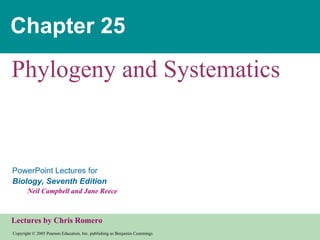Melden
Teilen

Weitere ähnliche Inhalte
Was ist angesagt?
Was ist angesagt? (20)
Phylogenetic tree and its construction and phylogeny of

Phylogenetic tree and its construction and phylogeny of
Ähnlich wie Chapter25
Ähnlich wie Chapter25 (20)
Ap Chapter 26 Evolutionary History Of Biological Diversity

Ap Chapter 26 Evolutionary History Of Biological Diversity
Kürzlich hochgeladen
Kürzlich hochgeladen (20)
Behind the Scenes From the Manager's Chair: Decoding the Secrets of Successfu...

Behind the Scenes From the Manager's Chair: Decoding the Secrets of Successfu...
Intro in Product Management - Коротко про професію продакт менеджера

Intro in Product Management - Коротко про професію продакт менеджера
FDO for Camera, Sensor and Networking Device – Commercial Solutions from VinC...

FDO for Camera, Sensor and Networking Device – Commercial Solutions from VinC...
ASRock Industrial FDO Solutions in Action for Industrial Edge AI _ Kenny at A...

ASRock Industrial FDO Solutions in Action for Industrial Edge AI _ Kenny at A...
The UX of Automation by AJ King, Senior UX Researcher, Ocado

The UX of Automation by AJ King, Senior UX Researcher, Ocado
Buy Epson EcoTank L3210 Colour Printer Online.pptx

Buy Epson EcoTank L3210 Colour Printer Online.pptx
Powerful Start- the Key to Project Success, Barbara Laskowska

Powerful Start- the Key to Project Success, Barbara Laskowska
UiPath Test Automation using UiPath Test Suite series, part 1

UiPath Test Automation using UiPath Test Suite series, part 1
Measures in SQL (a talk at SF Distributed Systems meetup, 2024-05-22)

Measures in SQL (a talk at SF Distributed Systems meetup, 2024-05-22)
Integrating Telephony Systems with Salesforce: Insights and Considerations, B...

Integrating Telephony Systems with Salesforce: Insights and Considerations, B...
The Value of Certifying Products for FDO _ Paul at FIDO Alliance.pdf

The Value of Certifying Products for FDO _ Paul at FIDO Alliance.pdf
Where to Learn More About FDO _ Richard at FIDO Alliance.pdf

Where to Learn More About FDO _ Richard at FIDO Alliance.pdf
How Red Hat Uses FDO in Device Lifecycle _ Costin and Vitaliy at Red Hat.pdf

How Red Hat Uses FDO in Device Lifecycle _ Costin and Vitaliy at Red Hat.pdf
Chapter25
- 1. Chapter 25 Phylogeny and Systematics
- 41. 4 Continuing the comparison of bases at sites 2, 3, and 4 reveals that each of these possible trees requires a total of four base-change events (marked again by crossbars). Thus, the first four sites in this DNA sequence do not help us identify the most parsimonious tree. 5 After analyzing sites 5 and 6, we find that the first tree requires fewer evolutionary events than the other two trees (two base changes versus four). Note that in these diagrams, we assume that the common ancestor had GG at sites 5 and 6. But even if we started with an AA ancestor, the first tree still would require only two changes, while four changes would be required to make the other hypotheses work. Keep in mind that parsimony only considers the total number of events, not the particular nature of the events (how likely the particular base changes are to occur). 6 At site 7, the three trees also differ in the number of evolutionary events required to explain the DNA data. RESULTS To identify the most parsimonious tree, we total all the base-change events noted in steps 3–6 (don’t forget to include the changes for site 1, on the facing page). We conclude that the first tree is the most parsimonious of these three possible phylogenies. (But now we must complete our search by investigating the 12 other possible trees.) Two base changes Figure 25.15b I II III IV I III II IV I IV II III I II III IV I III II IV I IV II III I II III IV I III II IV I IV II III I II III IV I III II IV I IV II III GG GG AA AA GG AA GG GG AA GG AA GG GG GG GG AA GG AA GG GG GG T G T G T T T T T G G T G T T G G T T T T 10 events 9 events 8 events
